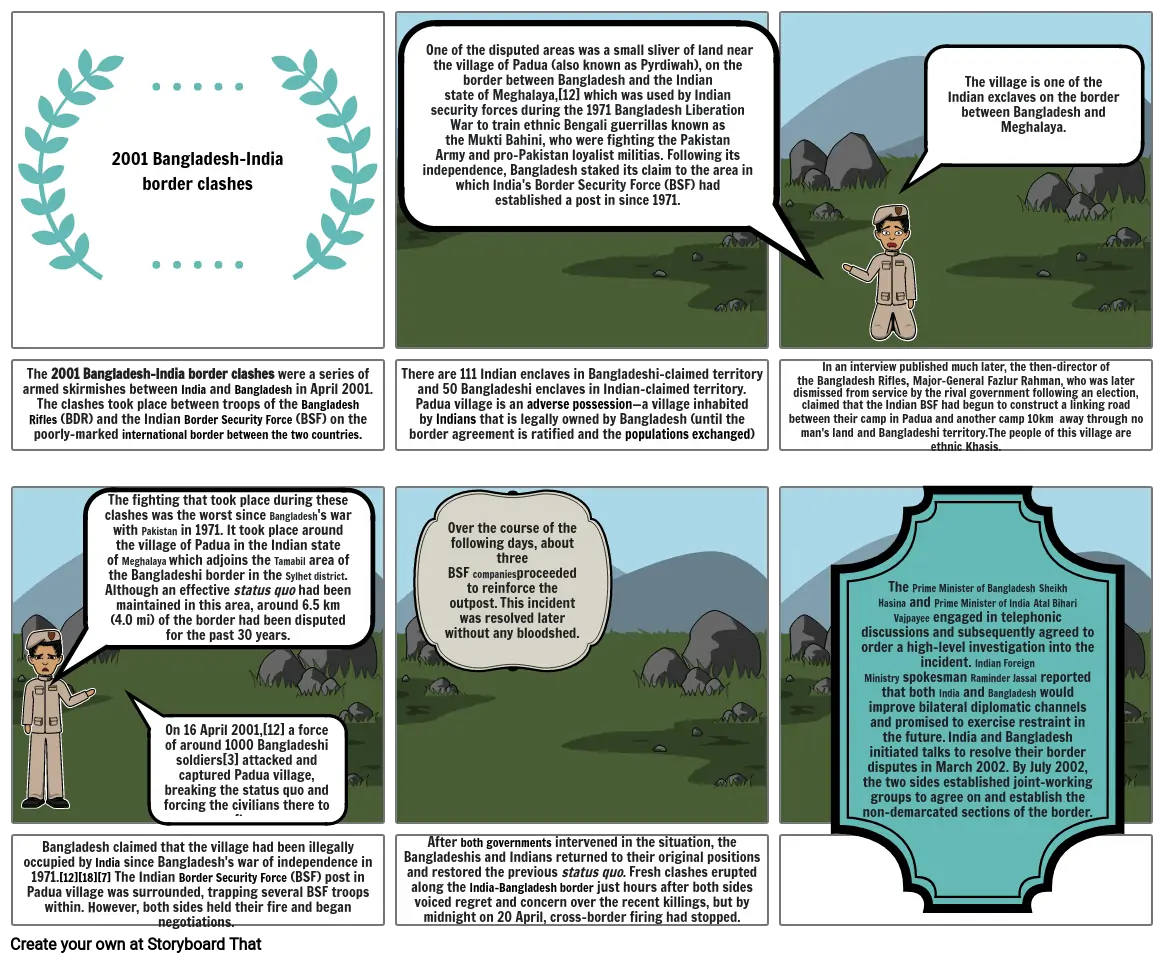Sst Storyboard

Storyboard Text
- 2001 Bangladesh–India border clashes
- One of the disputed areas was a small sliver of land near the village of Padua (also known as Pyrdiwah), on the border between Bangladesh and the Indian state of Meghalaya,[12] which was used by Indian security forces during the 1971 Bangladesh Liberation War to train ethnic Bengali guerrillas known as the Mukti Bahini, who were fighting the Pakistan Army and pro-Pakistan loyalist militias. Following its independence, Bangladesh staked its claim to the area in which India's Border Security Force (BSF) had established a post in since 1971.
- The village is one of the Indian exclaves on the border between Bangladesh and Meghalaya.
- The 2001 Bangladesh–India border clashes were a series of armed skirmishes between India and Bangladesh in April 2001. The clashes took place between troops of the Bangladesh Rifles (BDR) and the Indian Border Security Force (BSF) on the poorly-marked international border between the two countries.
- The fighting that took place during these clashes was the worst since Bangladesh's war with Pakistan in 1971. It took place around the village of Padua in the Indian state of Meghalaya which adjoins the Tamabil area of the Bangladeshi border in the Sylhet district. Although an effective status quo had been maintained in this area, around 6.5 km (4.0 mi) of the border had been disputed for the past 30 years.
- On 16 April 2001,[12] a force of around 1000 Bangladeshi soldiers[3] attacked and captured Padua village, breaking the status quo and forcing the civilians there to flee.
- There are 111 Indian enclaves in Bangladeshi-claimed territory and 50 Bangladeshi enclaves in Indian-claimed territory. Padua village is an adverse possession—a village inhabited by Indians that is legally owned by Bangladesh (until the border agreement is ratified and the populations exchanged)
- Over the course of the following days, about three BSF companiesproceeded to reinforce the outpost. This incident was resolved later without any bloodshed.
- In an interview published much later, the then-director of the Bangladesh Rifles, Major-General Fazlur Rahman, who was later dismissed from service by the rival government following an election, claimed that the Indian BSF had begun to construct a linking road between their camp in Padua and another camp 10km away through no man's land and Bangladeshi territory.The people of this village are ethnic Khasis.
- The Prime Minister of Bangladesh Sheikh Hasina and Prime Minister of India Atal Bihari Vajpayee engaged in telephonic discussions and subsequently agreed to order a high-level investigation into the incident. Indian Foreign Ministry spokesman Raminder Jassal reported that both India and Bangladesh would improve bilateral diplomatic channels and promised to exercise restraint in the future. India and Bangladesh initiated talks to resolve their border disputes in March 2002. By July 2002, the two sides established joint-working groups to agree on and establish the non-demarcated sections of the border.
- Bangladesh claimed that the village had been illegally occupied by India since Bangladesh's war of independence in 1971.[12][18][7] The Indian Border Security Force (BSF) post in Padua village was surrounded, trapping several BSF troops within. However, both sides held their fire and began negotiations.
- After both governments intervened in the situation, the Bangladeshis and Indians returned to their original positions and restored the previous status quo. Fresh clashes erupted along the India–Bangladesh border just hours after both sides voiced regret and concern over the recent killings, but by midnight on 20 April, cross-border firing had stopped.
Over 30 Million Storyboards Created

